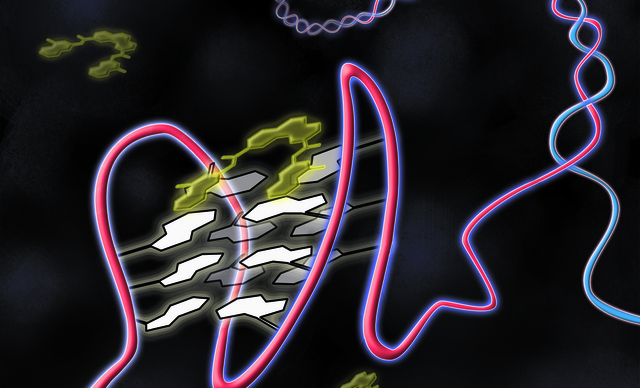Therapeutic prospects of G-quadruplexes against cancer
Small molecules with the ability to bind onto a single DNA structure, a kind of node which could block basic cell functions. That was all that was needed for biologists and chemists to join forces to develop new ones and test their anti-tumour potential.

At the heart of the cell, the DNA twists to form the famous double helix discovered by Watson and Crick in 1953. The recent observation of a four-strand structure – unstable and transitory – of DNA was enough to intrigue scientists. These unusual structures, called G-quadruplexes, are formed in guanine-rich genomic domains. They are four-strand structures formed by the self-association of 4 guanines in quartets which stack by trapping potassium ions. Due to this particularity, quadruplexes are nucleic acid structures unique in the world.
“They form local folds which disrupt the binding and progression of proteins, in particular during cell division. Depending on the genomic domains where they are formed, they apparently play several roles: transcription regulation, genome rearrangements, telomere dysfunctions, epigenetic instability, etc.”, said Marie-Paule Teulade-Fichou, director of the unit Chimie, Modélisation et Imagerie pour la Biologie (CNRS/Inserm/Institut Curie), and coordinator of the programme.
“In short, the persistence of these structures could block cell division or the expression of some genes. However, by disrupting these functions in the tumour cells, we hope to prevent them from proliferating or at least to render them less aggressive”, added the researcher Arturo Londono, director of the Genetic Information Dynamic Unit (CNRS/Institut Curie) and a partner in this programme.
By binding small molecules on the G-quadruplex structures, the researchers hope to stabilise those structures and bring about the destruction of the cells. “To a chemist, G-quadruplexes have the capacity to be targeted easily by small molecules”, explained Marie-Paule Teulade Fichou, who was the first to design molecules to stabilise G-quadruplexes and thus enable them to be studied in a cell medium. Within the framework of this programme, which includes chemists and biologists, new molecules which target these specific structures effectively should be tested in vivo. “Due to their mode of action, these small molecules appear to present less toxicity than some of the chemotherapy agents used at present”, added Arturo Londono. This is one of the points, as yet little known, which will be studied by means of this programme, in addition to an evaluation of the therapeutic potential of this new class of medicine. There is no doubt that this PIC3i will facilitate the discovery of new small molecules, combining anti-tumour efficacy and low toxicity.
Find out more
Coordinator :
- Marie-Paule Teulade Fichou, head of the Conception, synthesis and targeting of biomolécules lab
Partner :
- Arturo Londono, head of the Dynamics of genetic information: fundamental basis and cancer lab,
- Alain Nicolas, team leader Recombination and genetic instability,
- Steve Jackson du Gurdon institute (Cambridge, Grande-Bretagne)
